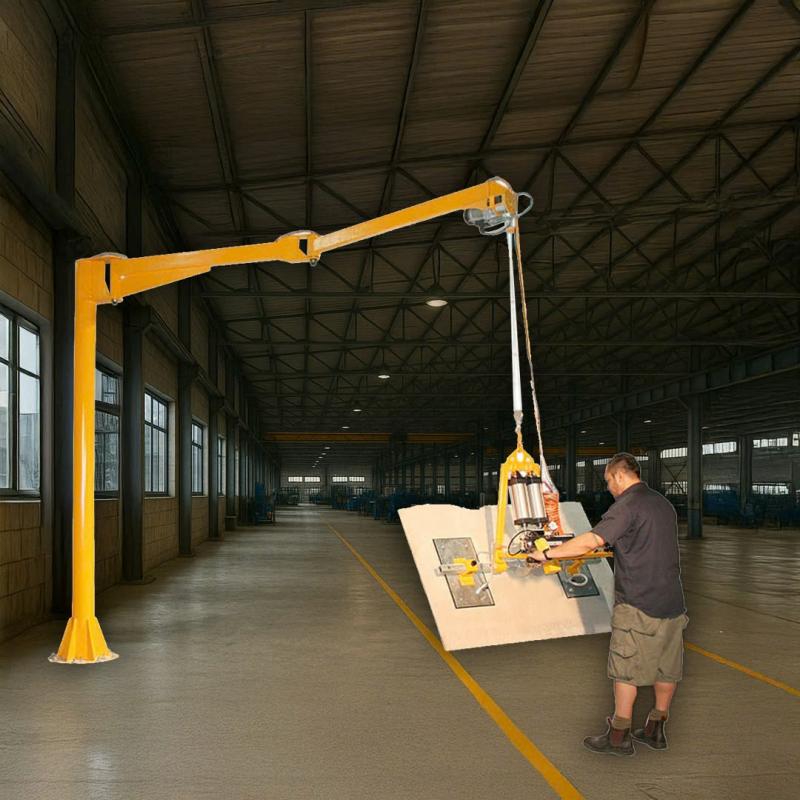



Among the most widely adopted systems are jib cranes, offering unmatched versatility in repetitive and localized lifting applications. But how do jib cranes compare to other modern lifting systems like davit arms, gantry cranes, or wall hoists?
This article dives deep into the world of jib cranes, exploring their types, advantages, and applications—while comparing them to other lifting solutions to help buyers make smarter investments.
A jib crane is a type of overhead lifting device consisting of a rotating horizontal arm (jib or boom) attached to a vertical mast or support. The boom carries a hoist and trolley that can lift, lower, and horizontally move materials within a defined radius.
Designed for material handling tasks that require speed, accuracy, and flexibility, jib cranes reduce manual labor, increase throughput, and are commonly used in manufacturing, fabrication, automotive repair, and shipping environments.
Explore the full Jib Cranes Installation process and their structure breakdown.
Freestanding jib cranes are the most versatile and independent models, capable of a full 360° rotation. Installed on reinforced concrete foundations, they’re ideal for both indoor and outdoor use.
Wall-mounted jib cranes are bolted to a wall or column and provide 180°–200° rotation. These cranes are space-saving, perfect for facilities with limited floor space.
Ceiling-mounted jib cranes are suspended from a building’s structure, offering coverage without occupying floor space.
Articulating jib cranes have two pivot arms, enabling load movement around corners, under obstructions, and into confined areas.
Also called column-mounted or mast-type cranes, pillar jib cranes are known for their full 360° rotation and heavy-duty performance.
Jib cranes are often compared to other lifting devices like davit arms and gantry cranes. Each system has its place, but jib cranes stand out in several ways:
| Feature | Jib Cranes | Davit Arms | Gantry Cranes |
|---|---|---|---|
| Rotation Range | Up to 360° | 180°–360° | Linear movement only |
| Floor Space Required | Low to moderate | Minimal | High |
| Load Capacity | Up to 10 tons (varies) | Typically < 1 ton | High (varies by model) |
| Installation Type | Permanent or portable | Portable or fixed | Movable or track-based |
| Use Case | Repetitive zone lifting | Spot lifting | Large, variable area lifting |
When your operations require repetitive, localized lifting with minimal installation, jib cranes deliver the best mix of power, reach, and efficiency.
Learn how to Enhance Efficiency with a Jib Crane.
Manufacturers now offer highly engineered jib cranes with the following features:
Compare models with this Aardwolf Jib Cranes Comparison article for detailed breakdowns.
The lifting industry is evolving fast, with innovations like:
Get a glimpse of upcoming developments via Future Trends of Jib Cranes.
Correct installation ensures not only performance but also longevity. For freestanding or pillar-mounted cranes, foundations must meet engineering specifications. Wall- and ceiling-mounted models need structural assessments for safety.
Maintenance tasks include:
Proactive maintenance is essential to keeping your jib crane in top shape and avoiding unplanned downtime.
Jib cranes are one of the most efficient and adaptable lifting systems for modern workspaces. Whether you’re running a small fabrication shop or a high-throughput warehouse, there’s a jib crane design that suits your needs.
Compared to davit arms and gantry systems, jib cranes offer unmatched rotation, versatility, and cost-efficiency in compact zones.
When investing in lifting equipment, evaluate your operation’s size, load type, and flow requirements. With the right setup—and the right supplier—you can expect years of reliable service, improved workflow, and safer material handling operations.
References
1. How to operate a Jib Cranes safely
3. Over brace jib crane wall mounted
5. Is a Jib Crane a Gantry Crane
6. Articulated Jib Crane Wall Mounted
8. Manual Counterbalance Crane
10. Over Braced Jib Crane Column Mounted
Sign up to receive the latest info on new Aardwolf products, special offers and more.
By signing up you agree to receive emails from Aardwolf with news, special offers, promotions and other information. You can unsubscribe at any time.